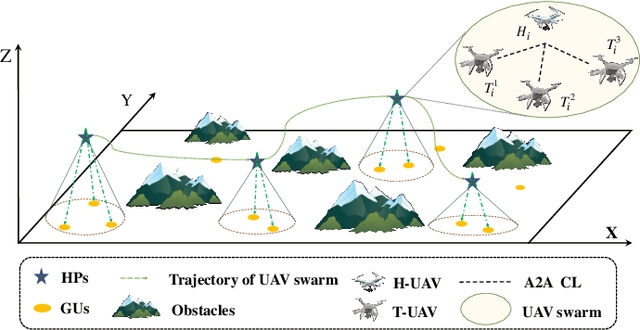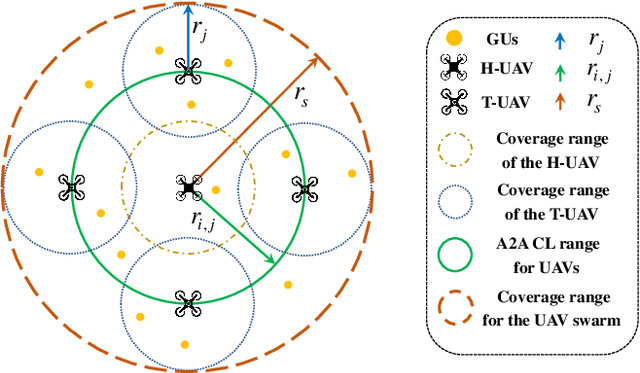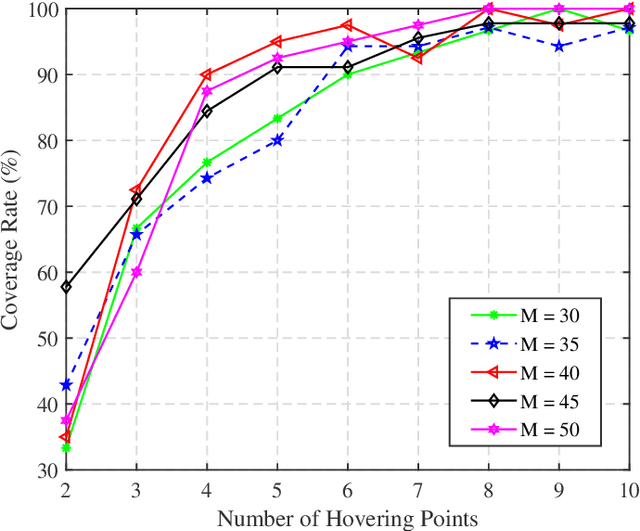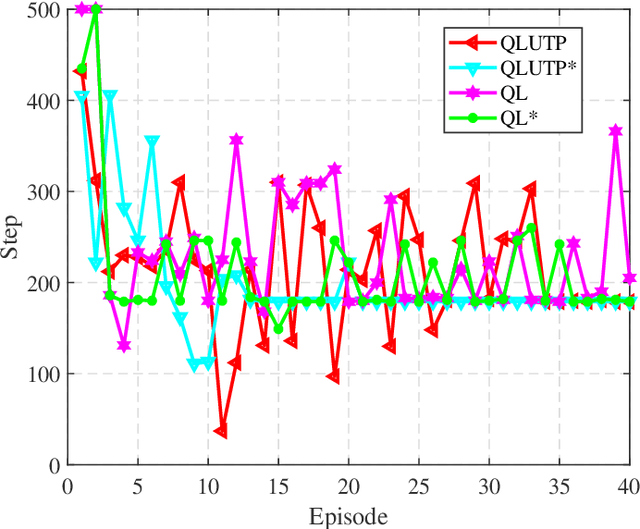Ziye Jia
CNN+Transformer Based Anomaly Traffic Detection in UAV Networks for Emergency Rescue
Mar 26, 2025Abstract:The unmanned aerial vehicle (UAV) network has gained significant attentions in recent years due to its various applications. However, the traffic security becomes the key threatening public safety issue in an emergency rescue system due to the increasing vulnerability of UAVs to cyber attacks in environments with high heterogeneities. Hence, in this paper, we propose a novel anomaly traffic detection architecture for UAV networks based on the software-defined networking (SDN) framework and blockchain technology. Specifically, SDN separates the control and data plane to enhance the network manageability and security. Meanwhile, the blockchain provides decentralized identity authentication and data security records. Beisdes, a complete security architecture requires an effective mechanism to detect the time-series based abnormal traffic. Thus, an integrated algorithm combining convolutional neural networks (CNNs) and Transformer (CNN+Transformer) for anomaly traffic detection is developed, which is called CTranATD. Finally, the simulation results show that the proposed CTranATD algorithm is effective and outperforms the individual CNN, Transformer, and LSTM algorithms for detecting anomaly traffic.
Joint ADS-B in B5G for Hierarchical UAV Networks: Performance Analysis and MEC Based Optimization
Mar 18, 2025Abstract:Unmanned aerial vehicles (UAVs) play significant roles in multiple fields, which brings great challenges for the airspace safety. In order to achieve efficient surveillance and break the limitation of application scenarios caused by single communication, we propose the collaborative surveillance model for hierarchical UAVs based on the cooperation of automatic dependent surveillance-broadcast (ADS-B) and 5G. Specifically, UAVs are hierarchical deployed, with the low-altitude central UAV equipped with the 5G module, and the high-altitude central UAV with ADS-B, which helps automatically broadcast the flight information to surrounding aircraft and ground stations. Firstly, we build the framework, derive the analytic expression, and analyze the channel performance of both air-to-ground (A2G) and air-to-air (A2A). Then, since the redundancy or information loss during transmission aggravates the monitoring performance, the mobile edge computing (MEC) based on-board processing algorithm is proposed. Finally, the performances of the proposed model and algorithm are verified through both simulations and experiments. In detail, the redundant data filtered out by the proposed algorithm accounts for 53.48%, and the supplementary data accounts for 16.42% of the optimized data. This work designs a UAV monitoring framework and proposes an algorithm to enhance the observability of trajectory surveillance, which helps improve the airspace safety and enhance the air traffic flow management.
Generative AI-Enhanced Cooperative MEC of UAVs and Ground Stations for Unmanned Surface Vehicles
Feb 12, 2025Abstract:The increasing deployment of unmanned surface vehicles (USVs) require computational support and coverage in applications such as maritime search and rescue. Unmanned aerial vehicles (UAVs) can offer low-cost, flexible aerial services, and ground stations (GSs) can provide powerful supports, which can cooperate to help the USVs in complex scenarios. However, the collaboration between UAVs and GSs for USVs faces challenges of task uncertainties, USVs trajectory uncertainties, heterogeneities, and limited computational resources. To address these issues, we propose a cooperative UAV and GS based robust multi-access edge computing framework to assist USVs in completing computational tasks. Specifically, we formulate the optimization problem of joint task offloading and UAV trajectory to minimize the total execution time, which is in the form of mixed integer nonlinear programming and NP-hard to tackle. Therefore, we propose the algorithm of generative artificial intelligence-enhanced heterogeneous agent proximal policy optimization (GAI-HAPPO). The proposed algorithm integrates GAI models to enhance the actor network ability to model complex environments and extract high-level features, thereby allowing the algorithm to predict uncertainties and adapt to dynamic conditions. Additionally, GAI stabilizes the critic network, addressing the instability of multi-agent reinforcement learning approaches. Finally, extensive simulations demonstrate that the proposed algorithm outperforms the existing benchmark methods, thus highlighting the potentials in tackling intricate, cross-domain issues in the considered scenarios.
Robust UAV Path Planning with Obstacle Avoidance for Emergency Rescue
Jan 16, 2025Abstract:The unmanned aerial vehicles (UAVs) are efficient tools for diverse tasks such as electronic reconnaissance, agricultural operations and disaster relief. In the complex three-dimensional (3D) environments, the path planning with obstacle avoidance for UAVs is a significant issue for security assurance. In this paper, we construct a comprehensive 3D scenario with obstacles and no-fly zones for dynamic UAV trajectory. Moreover, a novel artificial potential field algorithm coupled with simulated annealing (APF-SA) is proposed to tackle the robust path planning problem. APF-SA modifies the attractive and repulsive potential functions and leverages simulated annealing to escape local minimum and converge to globally optimal solutions. Simulation results demonstrate that the effectiveness of APF-SA, enabling efficient autonomous path planning for UAVs with obstacle avoidance.
Interference Analysis for Coexistence of UAVs and Civil Aircrafts Based on Automatic Dependent Surveillance-Broadcast
Jun 12, 2024Abstract:Due to the advantages of high mobility and easy deployment, unmanned aerial vehicles (UAVs) are widely applied in both military and civilian fields. In order to strengthen the flight surveillance of UAVs and guarantee the airspace safety, UAVs can be equipped with the automatic dependent surveillance-broadcast (ADS-B) system, which periodically sends flight information to other aircrafts and ground stations (GSs). However, due to the limited resource of channel capacity, UAVs equipped with ADS-B results in the interference between UAVs and civil aircrafts (CAs), which further impacts the accuracy of received information at GSs. In detail, the channel capacity is mainly affected by the density of aircrafts and the transmitting power of ADS-B. Hence, based on the three-dimensional poisson point process, this work leverages the stochastic geometry theory to build a model of the coexistence of UAVs and CAs and analyze the interference performance of ADS-B monitoring system. From simulation results, we reveal the effects of transmitting power, density, threshold and pathloss on the performance of the ADS-B monitoring system. Besides, we provide the suggested transmitting power and density for the safe coexistence of UAVs and CAs.
Cooperative Cognitive Dynamic System in UAV Swarms: Reconfigurable Mechanism and Framework
May 18, 2024Abstract:As the demands for immediate and effective responses increase in both civilian and military domains, the unmanned aerial vehicle (UAV) swarms emerge as effective solutions, in which multiple cooperative UAVs can work together to achieve specific goals. However, how to manage such complex systems to ensure real-time adaptability lack sufficient researches. Hence, in this paper, we propose the cooperative cognitive dynamic system (CCDS), to optimize the management for UAV swarms. CCDS leverages a hierarchical and cooperative control structure that enables real-time data processing and decision. Accordingly, CCDS optimizes the UAV swarm management via dynamic reconfigurability and adaptive intelligent optimization. In addition, CCDS can be integrated with the biomimetic mechanism to efficiently allocate tasks for UAV swarms. Further, the distributed coordination of CCDS ensures reliable and resilient control, thus enhancing the adaptability and robustness. Finally, the potential challenges and future directions are analyzed, to provide insights into managing UAV swarms in dynamic heterogeneous networking.
Joint ADS-B in 5G for Hierarchical Aerial Networks: Performance Analysis and Optimization
Apr 29, 2024Abstract:Unmanned aerial vehicles (UAVs) are widely applied in multiple fields, which emphasizes the challenge of obtaining UAV flight information to ensure the airspace safety. UAVs equipped with automatic dependent surveillance-broadcast (ADS-B) devices are capable of sending flight information to nearby aircrafts and ground stations (GSs). However, the saturation of limited frequency bands of ADS-B leads to interferences among UAVs and impairs the monitoring performance of GS to civil planes. To address this issue, the integration of the 5th generation mobile communication technology (5G) with ADS-B is proposed for UAV operations in this paper. Specifically, a hierarchical structure is proposed, in which the high-altitude central UAV is equipped with ADS-B and the low-altitude central UAV utilizes 5G modules to transmit flight information. Meanwhile, based on the mobile edge computing technique, the flight information of sub-UAVs is offloaded to the central UAV for further processing, and then transmitted to GS. We present the deterministic model and stochastic geometry based model to build the air-to-ground channel and air-to-air channel, respectively. The effectiveness of the proposed monitoring system is verified via simulations and experiments. This research contributes to improving the airspace safety and advancing the air traffic flow management.
Energy-Efficient Data Offloading for Earth Observation Satellite Networks
Jan 12, 2024



Abstract:In Earth Observation Satellite Networks (EOSNs) with a large number of battery-carrying satellites, proper power allocation and task scheduling are crucial to improving the data offloading efficiency. As such, we jointly optimize power allocation and task scheduling to achieve energy-efficient data offloading in EOSNs, aiming to balance the objectives of reducing the total energy consumption and increasing the sum weights of tasks. First, we derive the optimal power allocation solution to the joint optimization problem when the task scheduling policy is given. Second, leveraging the conflict graph model, we transform the original joint optimization problem into a maximum weight independent set problem when the power allocation strategy is given. Finally, we utilize the genetic framework to combine the above special solutions as a two-layer solution for the joint optimization problem. Simulation results demonstrate that our proposed solution can properly balance the sum weights of tasks and the total energy consumption, achieving superior system performance over the current best alternatives.
UAV Swarm Deployment and Trajectory for 3D Area Coverage via Reinforcement Learning
Sep 21, 2023



Abstract:Unmanned aerial vehicles (UAVs) are recognized as promising technologies for area coverage due to the flexibility and adaptability. However, the ability of a single UAV is limited, and as for the large-scale three-dimensional (3D) scenario, UAV swarms can establish seamless wireless communication services. Hence, in this work, we consider a scenario of UAV swarm deployment and trajectory to satisfy 3D coverage considering the effects of obstacles. In detail, we propose a hierarchical swarm framework to efficiently serve the large-area users. Then, the problem is formulated to minimize the total trajectory loss of the UAV swarm. However, the problem is intractable due to the non-convex property, and we decompose it into smaller issues of users clustering, UAV swarm hovering points selection, and swarm trajectory determination. Moreover, we design a Q-learning based algorithm to accelerate the solution efficiency. Finally, we conduct extensive simulations to verify the proposed mechanisms, and the designed algorithm outperforms other referred methods.
Routing Recovery for UAV Networks with Deliberate Attacks: A Reinforcement Learning based Approach
Aug 14, 2023Abstract:The unmanned aerial vehicle (UAV) network is popular these years due to its various applications. In the UAV network, routing is significantly affected by the distributed network topology, leading to the issue that UAVs are vulnerable to deliberate damage. Hence, this paper focuses on the routing plan and recovery for UAV networks with attacks. In detail, a deliberate attack model based on the importance of nodes is designed to represent enemy attacks. Then, a node importance ranking mechanism is presented, considering the degree of nodes and link importance. However, it is intractable to handle the routing problem by traditional methods for UAV networks, since link connections change with the UAV availability. Hence, an intelligent algorithm based on reinforcement learning is proposed to recover the routing path when UAVs are attacked. Simulations are conducted and numerical results verify the proposed mechanism performs better than other referred methods.
 Add to Chrome
Add to Chrome Add to Firefox
Add to Firefox Add to Edge
Add to Edge